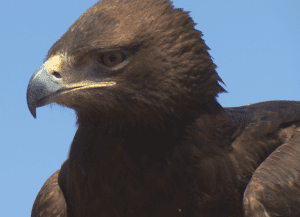
by Pigeon Patrol | May 19, 2016 | 4-S Gel Bird repellent, Animal Deterrent Products, Bird Deterrent Products, Bird Netting
 Marlborough Falcon Trust handler, Rob Lawry, is using Tappe the falcon on the campus at University of Canterbury to scare away pigeons as a humane pest control measure.
Marlborough Falcon Trust handler, Rob Lawry, is using Tappe the falcon on the campus at University of Canterbury to scare away pigeons as a humane pest control measure.
The University of Canterbury (UC) hopes a native falcon will eradicate hundreds of pigeons plaguing the campus.
In its latest move to reduce the pigeon population, a karearea bird – as pictured on the $20 banknote – has been trained to make territorial flights to scare off flocks of pest birds from buildings and the campus.
Marlborough Falcon Trust handlers Vikki Smith and Rob Lawry have been free-flying the specially bred one-year-old karearea, called Tappe, in what is believed to be the first programme of its kind in New Zealand.
Hundreds of pigeons are plaguing the University of Canterbury campus.
UC engineering services manager Rob Oudshoorn said the pigeon problem had “escalated dramatically” since the quakes when central city roosting spots were pulled down.
Combined with an abundance of food from the ruined city and the campus’ proximity to town, the university’s pigeon population has ballooned into the hundreds and affects more than 20 buildings.
The falcon is the university’s latest innovation to solve the problem after unsuccessful attempts using electric fencing, spikes and controlled culling with slug guns, Oudshoorn said.
Marlborough Falcon Trust handler Rob Lawry hopes Tappe, a karearea bird, will stop University of Canterbury’s pigeon problem.
Excrement is the biggest problem the birds bring as it piles around doors, windows, footpaths, and roofs, he said. Where pigeon numbers are high, buildings deteriorate more rapidly and the spread of disease increases.
“And depending on the scale of it, it can become quite an issue. In the extreme if it’s left there for a long period of time, those piles of excrement bring in maggots, and the excrement itself is pretty toxic too really.”
With a population of around 6000, karearea are rare. They are a natural predator to pigeons, which use avoidance and escape as a natural defence.
The natural bird control technique is used around the world, including Dubai, airports and London’s Trafalgar Square.
Lawry said the birds are trained to fly to a lure held by an instructor, rather than to capture birds.
“As the falcon comes rocketing towards the lure I pass it behind me in the direction I want it to travel, and so he goes up high in that direction. When he goes high the pigeons will go ‘I’m out of here because there’s a falcon here’. But at that point if there’s a really slow pigeon the falcon might get it.”
Lawry said Tappe had responded well to training at UC and would expand the program
About Pigeon Patrol:
Pigeon Patrol Products & Services is the leading manufacturer and distributor of bird deterrent (control) products in Canada. Pigeon Patrol products have solved pest bird problems in industrial, commercial, and residential settings since 2000, by using safe and humane bird deterrents with only bird and animal friendly solutions. At Pigeon Patrol, we manufacture and offer a variety of bird deterrents, ranging from Ultra-flex Bird Spikes with UV protection, Bird Netting, 4-S Gel and the best Ultrasonic and audible sound devices on the market today.
Voted Best Canadian wholesaler for Bird Deterrent products four years in a row.
Contact Info: 1- 877– 4– NO-BIRD (www.pigeonpatrol.ca)
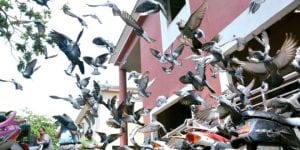
by Pigeon Patrol | May 15, 2016 | Bird Deterrent Products, Bird Netting, Pigeon Patrol's Services, Pigeon Spikes
 COMMUTERS using the Bandar Baru Kuala Selangor Bus Terminal are in a flap over pigeons roosting in the rafters of the vandalised first floor of the bus station that used to be occupied by traders.
COMMUTERS using the Bandar Baru Kuala Selangor Bus Terminal are in a flap over pigeons roosting in the rafters of the vandalised first floor of the bus station that used to be occupied by traders.
Office workers and traders working opposite the bus terminal were worried that the thick covering of dried pigeon droppings on the first floor could be carried by the winds and lead to a number of illnesses.
Feral rock pigeons, which are stout-bodied and pale grey birds with black patterns, are often seen scavenging for food in flocks around the bus station before returning to their “homes” on the first floor in the late evenings.
Bandar Baru Kuala Selangor Bus Terminal is sandwiched by Jalan Melati 3/17 and Jalan 3/19 within the commercial quarter but there are also residential units in the surrounding area.
Businessman Chong Hee Fah, 58, said the shops on the first floor of the bus station had closed down in mid-2005 and unscrupulous individuals had stripped the aluminium and metal fittings from the shop lots.
“All the shop lots there have been damaged. I work within walking distance to the bus station and I am worried the pigeon droppings will cause illnesses.
Kuala Selangor Bus Terminals first floor covered in pigeon droppings is a health hazard.
Kuala Selangor Bus Terminal’s first floor covered in pigeon droppings is a health hazard.
“Fine particles of the bird droppings along with feathers sometimes land on our cars after a gust of wind blows through the bus terminal,” he added.
Assistant officer Amira Kadir, 22, who works for Kuala Selangor District Council (MDKS) Zone 3B councillor Nor Azhar Jamil, said the first floor of the bus station had been abandoned for some time and she hoped the local council would revive it.
Klang Consumer Association president Devadass Anjan urged MDKS to conduct an immediate clean up of the pigeon droppings at the bus station as these birds could transmit various diseases.
“Commuters, shoppers, people working around the area and even those living within a short distance from the bus station could suffer from respiratory diseases, rashes and allergies.
“Children would be more at risk and MDKS must clean up the bus station,” he said.
Devadass added that MDKS must install pigeon spikes on the ledges and fence up the openings of the first floor to curb the problem.
The first floor of the Kuala Selangor Bus Terminal off Jalan Melati 3/19 that used to house various trading booths have been abandoned and is now a place for pigeons to roost making it a messy affair and health hazard. —Photos by KAMARUL ARIFFIN/The Star
The first floor of the Kuala Selangor Bus Terminal off Jalan Melati 3/19 that used to house various trading booths have been abandoned and is now a place for pigeons to roost making it a messy affair and health hazard.
According to a medical practitioner, pigeon droppings could cause histoplasmosis, a fungal disease that develops in the droppings and is carried by the wind.
“Signs of histoplasmosis begin to show about two weeks after initial infection and it causes tiredness, fever and chest pains,” she said.
MDKS secretary Azahari Sairin said the pigeon problem at the bus station was difficult to solve as the first floor had been abandoned for a decade.
“For 10 years, the first floor had been left vacant. For a short time, there were other businesses but most left within a month or two.
“As a result of food remnants available in back lanes and some people feeding the pigeons, the flock has thrived,” he said.
Azahari said MDKS would conduct a thorough clean up of the first floor and use bristling wires or spikes to fence the openings to discourage the birds from getting into the building.
“MDKS has allocated RM50,000 to refurbish the first floor of the bus station and work will begin in the first quarter of 2016.
“Our aim is to encourage the sale of local handicraft and household decorations that could bring tourists and locals to the commercial area,” he said.
About Pigeon Patrol:
Pigeon Patrol Products & Services is the leading manufacturer and distributor of bird deterrent (control) products in Canada. Pigeon Patrol products have solved pest bird problems in industrial, commercial, and residential settings since 2000, by using safe and humane bird deterrents with only bird and animal friendly solutions. At Pigeon Patrol, we manufacture and offer a variety of bird deterrents, ranging from Ultra-flex Bird Spikes with UV protection, Bird Netting, 4-S Gel and the best Ultrasonic and audible sound devices on the market today.
Voted Best Canadian wholesaler for Bird Deterrent products four years in a row.
Contact Info: 1- 877– 4– NO-BIRD (www.pigeonpatrol.ca)
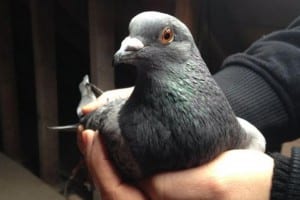
by Pigeon Patrol | May 12, 2016 | Bird Deterrent Products, Bird Netting, Pigeon Patrol's Services, Pigeon Spikes
 A pair of proteins may hold the key as to how animals like pigeons, sharks and bees sense the Earth’s magnetic field and use it to navigate, scientists say.
A pair of proteins may hold the key as to how animals like pigeons, sharks and bees sense the Earth’s magnetic field and use it to navigate, scientists say.
“This magnetic protein compass may explain how animals can navigate their way,” said lead researcher Dr Can Xie, a molecular biophysicist at Peking University in Beijing.
However another expert is not convinced the finding, reported in today’s issue of the journal Nature Materials, is the key to solving the mystery of how animals navigate.
Scientists have been trying for a long time to work out the biological machinery that enables animals — including pigeons, trout, sharks, bats, turtles, whales and bees — to sense the Earth’s magnetic field and use it for navigation.
Dr Xie and colleagues thought that since a broad range of animals possess this sense, there should be a single “evolutionarily conserved” system that is responsible.
The protein complex spontaneously aligns in the direction of external magnetic fields
Dr Can Xie, Peking University
Previous research has suggested that a light-sensitive protein in the eye called cryptochrome (Cry) plays a key role in magnetic sensing abilities, but Dr Xie and colleagues reasoned it would need to team up with other proteins to actually form a compass.
They screened the genome of fruit flies and discovered an iron-containing protein they dubbed MagR (for magneto-receptor), which can have features of a magnet when polymerised.
“For example MagR forms a rod-like polymer and can orient itself in the direction of a given magnetic field,” Dr Xie said.
He said computer modelling and experiments show how MagR couples with Cry, and that both the MagR polymer and MagR/Cry protein complex can actually respond to magnetic fields.
“The protein complex spontaneously aligns in the direction of external magnetic fields,” Dr Xie said.
“We also showed through immunohistochemical studies biochemical and biophysical methods that the MagR/Cry complex is stable in the retina of pigeons.
“Biochemical and biophysical methods indicated this complex can also forms in butterfly, rat, whale and human cells.
“This is all strong evidence indicators that this biological compass exists in animals.”
Dr Xie said further research was required to understand how Cry was helping MagR to become magnetic, and how signals from the compass were processed by the nervous system.
“To construct an entire and complete explanation of magnetoreception and magnetic navigation may take decades and probably several generations to complete,” he said.
Dr Xie, the discovery of such proteins could be used in the future for manipulating cells and molecules in the human body using magnetic fields.
New Zealand expert prefers the nose to the eyes
However, Professor Michael Walker of the University of Auckland, who has been studying magnetic sensing for decades, is not convinced by the latest findings.
I would back the magnetite hypothesis over the cryptochrome hypothesis
Professor Michael Walker
“It’s a very tentative suggestion,” he said.
“So far as I can tell, the evidence supplied by the researchers is in vitro, not in animals.
“There is no evidence that the correct conditions for the formation of the protein complex actually exists in the eye of animals.”
Professor Walker prefers another hypothesis — that animals navigate using cells in the nose containing crystals of an iron oxide known as magnetite.
He said a large body of research supports this, including experiments in which pigeons that have their noses anaesthetised can no longer navigate properly.
Such research suggests no input from the eyes is required for magnetic sensing.
“I would back the magnetite hypothesis over the cryptochrome hypothesis,” Professor Walker said.
While Dr Xie said that both hypotheses have “credible theoretical and experimental foundations”, Professor Walker said natural selection would make it highly unlikely there is more than one biological compass.
About Pigeon Patrol:
Pigeon Patrol Products & Services is the leading manufacturer and distributor of bird deterrent (control) products in Canada. Pigeon Patrol products have solved pest bird problems in industrial, commercial, and residential settings since 2000, by using safe and humane bird deterrents with only bird and animal friendly solutions. At Pigeon Patrol, we manufacture and offer a variety of bird deterrents, ranging from Ultra-flex Bird Spikes with UV protection, Bird Netting, 4-S Gel and the best Ultrasonic and audible sound devices on the market today.
Voted Best Canadian wholesaler for Bird Deterrent products four years in a row.
Contact Info: 1- 877– 4– NO-BIRD (www.pigeonpatrol.ca)

by Pigeon Patrol | May 11, 2016 | Animal Deterrent Products, Bird Deterrent Products, Bird Netting
 A MUM intends to fight an on-the-spot £50 fine for feeding pigeons in the city centre after claiming she had no idea it was an offence.
A MUM intends to fight an on-the-spot £50 fine for feeding pigeons in the city centre after claiming she had no idea it was an offence.
Claire Jenkins admitted doing that near Topshop in Oxford Street when confronted by a litter enforcement officer, but said that it only involved little scraps of bread.
“I bought a frankfurter for me and a burger for my 16-year-old son from one of the street outlets,” said Mrs Jenkins, of Clos Trafle, Gowerton. “We eat them on the bench there. We had little scraps left. I put mine on the bench and he put his on the ground. We walked to a bin to put our napkins in and when we turned around a warden said it was classified as litter. I thought he was joking. I live in Gowerton and never come into Swansea. I said I didn’t know about it and didn’t see any signs.”
Mrs Jenkins said she was given a £50 fixed penalty rising to £75 if not paid with seven days, and leading to a magistrates court appearance if the latter was not paid within 14 days.
Seagull feeding fines dropped because religions could be offended, but Swansea says not
“I found it degrading,” she said. “I was feeding crumbs. I didn’t know it was classed as an offence.”
A Swansea Council spokesman said: “We launched a city-wide campaign in the summer to encourage the public to put leftover food in the bin and not throw it on the ground for birds. This was following a request by city centre businesses whose customers say they have been plagued by seagulls that are causing a nuisance, particularly when people are consuming food.
“The feedback we received from visitors has been very positive. Posters have been put up on bins in the city centre advising shoppers of the penalties for littering and our message is that if you don’t drop litter you won’t face the fine.”
About Pigeon Patrol:
Pigeon Patrol Products & Services is the leading manufacturer and distributor of bird deterrent (control) products in Canada. Pigeon Patrol products have solved pest bird problems in industrial, commercial, and residential settings since 2000, by using safe and humane bird deterrents with only bird and animal friendly solutions. At Pigeon Patrol, we manufacture and offer a variety of bird deterrents, ranging from Ultra-flex Bird Spikes with UV protection, Bird Netting, 4-S Gel and the best Ultrasonic and audible sound devices on the market today.
Voted Best Canadian wholesaler for Bird Deterrent products four years in a row.
Contact Info: 1- 877– 4– NO-BIRD (www.pigeonpatrol.ca)
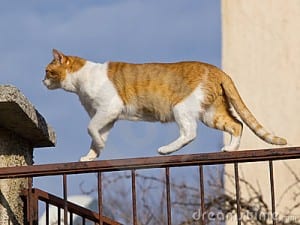
by Pigeon Patrol | May 9, 2016 | Animal Deterrent Products, Bird Deterrent Products, Bird Netting, Pigeon Spikes
 The Village of Lancaster has taken preventive measures to halt an increase in the feral cat and rat population.
The Village of Lancaster has taken preventive measures to halt an increase in the feral cat and rat population.
The Village Board passed a resolution on Monday accepting trap, neuter and return programs as viable and acceptable population control tools for the cats.
Where’s the story?
PointsMentioned Map7 Points Mentioned
Board members voted unanimously to allow people to go into areas affected by large populations of feral and free-roaming cats, trap them, spay or neuter them, and set them free. The groups humanely trap the cats and vaccinate them before they are released back into the areas where they were found.
Historically, the practice has been to trap the animals and kill them.
However, under what the village is calling the TNR program, the animals will act as placeholders, occupying territory and living their lives without more cats moving into the area. The existing cats will not have the means to reproduce if trapped, limiting the growth of population.
“In lieu of destroying feral cats, they are going to be gathered, neutered and released back to where they were found,” said Village Attorney Arthur Herdzik, who wrote the resolution. “Studies indicate that destroying them creates a vacuum that other cats fill. There is also a cruelty issue.”
Under the resolution, the trapping of cats is now legal in the village and residents are encouraged to participate.
The board was approached by Feral Cat FOCUS Inc., an all-volunteer, not-for-profit company that deals with cat populations in this manner for the safety of the animals and of the people who live in the affected neighborhoods.
“[FOCUS] approached me. It is a humane way to treat cats. They aren’t taken to a shelter. The Erie County Legislature is endorsing this,” said village Trustee Russell W. Sugg. “Groups like FOCUS will educate the public. There is no cost to the village.”
According to FOCUS, the group has already performed 60 to 70 recent procedures on cats in the Lancaster area.
Buffalo, Williamsville, Springville and West Seneca have recently passed similar legislation.
The village has also seen an increase in activity from rat populations.
According to Shawn Marshall, the village’s code enforcement officer, he has received around 75 calls from residents complaining about rats since he took the job in June.
“The downtown business district area has had problems for years now.” said Marshall.
Rats have become more active and are attracted to dog feces, open garbage cans, leaf and firewood piles, and vacant structures.
At this time, the village does not have lidded garbage totes for trash collection.
According to Marshall, the totes would have to be provided by the Town of Lancaster and the cost to provide the totes to residents would be in the millions of dollars as the current fleet of trucks is not fitted with tote lifts.
Residents can prevent any possible rat infestation by cleaning up leaf piles, lifting firewood piles off the ground, getting lidded garbage cans and regularly cleaning up any waste from pets and disposing of it properly.
If residents have a rat issue, they can contact the Erie County Health Department, which will bait the rats for disposal.
According to Marshall, the county will take care of the problem in about a week.
Marshall is no stranger to rats. Near his home on Como Park Boulevard near Aurora Street, he had a problem at the beginning of November. He returned home one night to see a rat on one of his decorative Halloween pumpkins.
Marshall said all he can do is direct people to the county Health Department.
Residents can contact the Erie County Health Department by calling 858-7690.
About Pigeon Patrol:
Pigeon Patrol Products & Services is the leading manufacturer and distributor of bird deterrent (control) products in Canada. Pigeon Patrol products have solved pest bird problems in industrial, commercial, and residential settings since 2000, by using safe and humane bird deterrents with only bird and animal friendly solutions. At Pigeon Patrol, we manufacture and offer a variety of bird deterrents, ranging from Ultra-flex Bird Spikes with UV protection, Bird Netting, 4-S Gel and the best Ultrasonic and audible sound devices on the market today.
Voted Best Canadian wholesaler for Bird Deterrent products four years in a row.
Contact Info: 1- 877– 4– NO-BIRD (www.pigeonpatrol.ca)
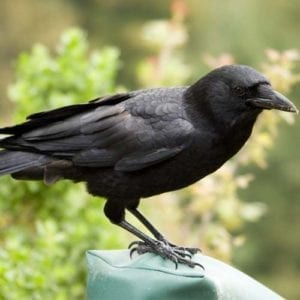
by Pigeon Patrol | May 8, 2016 | 4-S Gel Bird repellent, Animal Deterrent Products, Bird Deterrent Products, Bird Netting, Pigeon Spikes
 Back in February, the BBC posted a story about a Seattle girl who got gifts from crows. She was brought bolts, beads, buttons, earrings, and bones, among other things. It was also revealed that she feeds these animals. The essence of the story, the reason it went viral, is it so perfectly, in the popular imagination, captured an innocent relationship between a child and the wild. The birds understood her and she understood them. Like all children, she had not become a human (experienced) yet. She still had a primal connection with the animal kingdom.
Back in February, the BBC posted a story about a Seattle girl who got gifts from crows. She was brought bolts, beads, buttons, earrings, and bones, among other things. It was also revealed that she feeds these animals. The essence of the story, the reason it went viral, is it so perfectly, in the popular imagination, captured an innocent relationship between a child and the wild. The birds understood her and she understood them. Like all children, she had not become a human (experienced) yet. She still had a primal connection with the animal kingdom.
But even this paradise proved to be short-lived. By August, the neighbors of the girl were suing her family for attracting all manner of wild urban life to their upscale Seattle neighborhood, Portage Bay. Crows, pigeons, squirrels, and even rats, they claimed, had all learned about this girl and her generosity. Seagulls were seen as flying from Elliot Bay to Portage Bay with the certainty that the main problem of life will be solved there. The neighbors claimed that, as a consequence, the shit of these synanthropic animals spoiled their properties. They wanted $200,000 in damages. Now the girl’s family is fighting back, claiming their daughter’s feeding has not attracted rats and gulls.
What to make of this situation? I asked my favorite writer and thinker on crows, Lyanda Lynn Haupt (she wrote Crow Planet: Essential Wisdom from the Urban Wilderness), for her view on the escalating tensions in Portage Bay. She responded with a lovely and insightful letter:
I think that many people long for a sense of connection with wild animals. This story served up evidence of such a possibility, and it captured everyone’s imagination. Plus, let’s face it—that little girl is cute as pie. No wonder social media went crazy. Did the crow really bring gifts to the girl? Some crows do gather shiny bits of this and that—gum wrappers, thumb tacks, shells, foil, bright red berries—and cache them in one place. Little collections of treasure. I can see how this action could be interpreted as the bringing of gifts to the little girl with the food, and there is little harm in imagining this to be so. That said, there is no reason to be feeding crows. They are already flourishing in the urban environment, and the neighbors are right—the amount of food it takes to bring in that many crows can make a mess and invite even more problematical urban wildlife. Even in this little video there are squirrels and pigeons. Whether there is evidence of rats or not, they are common visitors to urban bird feeders, even much smaller ones.
The neighbors are freaking out a bit. It is not “The Birds.” No one is going to get sick. And hanging dead crows on your porch (legal or not) to deter the neighbors and their crow visitors is just creepy. But lots of crows and pigeons and food and mess around? I agree, not good. Loud, annoying. And not in line with a deeper understanding of what helps and what harms urban wildlife. To live well alongside urban wildlife and our human neighbors: Keep cat and dog food inside (so as not to attract rodents, raccoons, coyotes, and crows). Close up entrance holes to keep animals from entering to shelter or nest. And if you do feed birds: just small feeders for small birds, cleaned scrupulously, with seeds that fall beneath cleaned up daily. Better would be to plant native trees and shrubs with seeds and berries that local birds love. I think it is a beautiful privilege to live alongside wild creatures close to home. But we need to do it with some grace and wisdom.
I think the story is sticking around so long because of the winning combination: cute girl with pet wild birds and lawsuit!
There is one more thing. I think if the crow feeder was a boy, the neighborhood may not have been so aggressive and filed a lawsuit. What is seen as annoying in a girl is often registered as a gift in a boy.
About Pigeon Patrol:
Pigeon Patrol Products & Services is the leading manufacturer and distributor of bird deterrent (control) products in Canada. Pigeon Patrol products have solved pest bird problems in industrial, commercial, and residential settings since 2000, by using safe and humane bird deterrents with only bird and animal friendly solutions. At Pigeon Patrol, we manufacture and offer a variety of bird deterrents, ranging from Ultra-flex Bird Spikes with UV protection, Bird Netting, 4-S Gel and the best Ultrasonic and audible sound devices on the market today.
Voted Best Canadian wholesaler for Bird Deterrent products four years in a row.
Contact Info: 1- 877– 4– NO-BIRD (www.pigeonpatrol.ca)

 Marlborough Falcon Trust handler, Rob Lawry, is using Tappe the falcon on the campus at University of Canterbury to scare away pigeons as a humane pest control measure.
Marlborough Falcon Trust handler, Rob Lawry, is using Tappe the falcon on the campus at University of Canterbury to scare away pigeons as a humane pest control measure.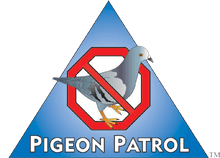

 COMMUTERS using the Bandar Baru Kuala Selangor Bus Terminal are in a flap over pigeons roosting in the rafters of the vandalised first floor of the bus station that used to be occupied by traders.
COMMUTERS using the Bandar Baru Kuala Selangor Bus Terminal are in a flap over pigeons roosting in the rafters of the vandalised first floor of the bus station that used to be occupied by traders.
 A pair of proteins may hold the key as to how animals like pigeons, sharks and bees sense the Earth’s magnetic field and use it to navigate, scientists say.
A pair of proteins may hold the key as to how animals like pigeons, sharks and bees sense the Earth’s magnetic field and use it to navigate, scientists say.
 A MUM intends to fight an on-the-spot £50 fine for feeding pigeons in the city centre after claiming she had no idea it was an offence.
A MUM intends to fight an on-the-spot £50 fine for feeding pigeons in the city centre after claiming she had no idea it was an offence.
 The Village of Lancaster has taken preventive measures to halt an increase in the feral cat and rat population.
The Village of Lancaster has taken preventive measures to halt an increase in the feral cat and rat population.
 Back in February, the BBC posted a story about a Seattle girl who got gifts from crows. She was brought bolts, beads, buttons, earrings, and bones, among other things. It was also revealed that she feeds these animals. The essence of the story, the reason it went viral, is it so perfectly, in the popular imagination, captured an innocent relationship between a child and the wild. The birds understood her and she understood them. Like all children, she had not become a human (experienced) yet. She still had a primal connection with the animal kingdom.
Back in February, the BBC posted a story about a Seattle girl who got gifts from crows. She was brought bolts, beads, buttons, earrings, and bones, among other things. It was also revealed that she feeds these animals. The essence of the story, the reason it went viral, is it so perfectly, in the popular imagination, captured an innocent relationship between a child and the wild. The birds understood her and she understood them. Like all children, she had not become a human (experienced) yet. She still had a primal connection with the animal kingdom.